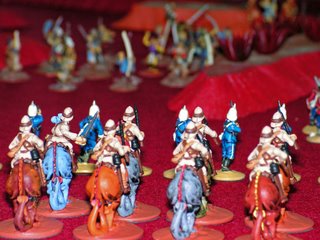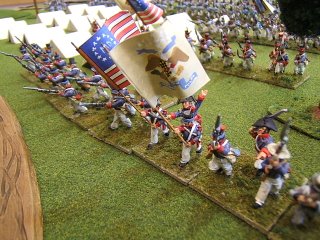


The Hundred Years War is actually a bit longer than a century in length, and its causes are rooted in power (aren’t all conflicts?) The English King as a holder of certain territories in Gascony was a vassal of the French king. Edward the III upon his accession to the Crown refused to give homage to the French king, which Edward knew would lead to war in his French territories. Constantly short of funds, he sought allies in Flanders. The French, meanwhile built a fleet and hired additional galleys from Genoa in preparation to an invasion of England. The first great battle in 1340, was a disaster for the French, was fought at the Flemish port of Sluys. Basically a land battle at sea, the French lost their fleet and a great many men to English longbows.
Despite several abortive campaigns, Edward finally assembled his first land expedition north of Bordeaux in 1346. Landing in Normandy, he marched his army through villages familiar to Americans that would land there nearly 600 years later. In a pattern that would remain familiar throughout much of the HYW, the French King Philip VI, assembled an army and pursued Edward through Normandy into Ponthieu and met disaster at Crecy. Edward followed up his victory with the capture of Calais and insured a permanent military base near the heart of France throughout this conflict.
In 1348 the combatants were visited by the first wave of the Black Plague, disrupting campaigning, trade, economies and societies for years to come. Conflict remained low-level due to a lack of money and manpower until 1356, when Edward’s son, the Prince of Wales, also known as The Black Prince led a Chevauchee, an expedition devoted to accumulating loot and inflicting considerable discomfort to local inhabitants in the Loire valley north of Bordeaux. King Jean le Bon led an army south to destroy the Prince and his army, and the two forces met near the Foret de Noailles. Though the battle was hard fought, the French were defeated and King Jean was captured.
The capture of the French king and his nobles, and their crushing ransom drove the French to ask for a series of truces that left France in relative peace, though beset by political turmoil at home. It also left England in nominal control of Normandy, and enlarged Biscay possessions. The Treaty of Bretigny, in 1361, was a disaster for France and ended the first stage of the Hundred Years War.
The second stage of the conflict found both of the combatants faced with innumerable challenges and dynastic struggle. However, the premature death of the Prince of Wales, Edward III’s long slide into dotage, and the cost of sustaining a continuing campaign in France, restrained the English war effort. In 1364 a more capable monarch, Charles V, ascended the French throne. Together with his constable, the incomparable Betrand du Guesclin, Charles set about reducing the strife within his kingdom, and succeeded in winning back many of the French gains in the Angevin territories as well as much of much of the northern lands, except Calais.
By 1380 however, both nations were exhausted, ruled by young kings. Richard II became king in 1377 on the death of his grandfather Edward III. England, impoverished by years of war was immersed in the Peasant’s Revolt. Guided by poor advice, Richard was deposed by the Henry of Lancaster (Henry IV) in 1399, and England plunged into a decade of civil war and a stubborn revolt by the neighboring Welsh. France, likewise was ruled by a youth, Charles VI, for many years. Charles exhibited many signs of mental illness, and his chaotic rule plunged the country into civil war.
Succeeding his father in 1413, Henry V demanded the crown of France and led his army into France capturing Harfleur and inflicting the disastrous defeat of Agincourt on the French army. Henry showed a genius for siege warfare that his English predecessors lacked, captured and occupied both Rouen and Paris and forced a treaty on the French in 1420 that recognized his future heirs as king of France and England, and in the bargain married Katherine, the daughter of the Charles VI. Henry’s death in 1422, left his infant son under the tutelage of his mother and various advisors
The waning years of the Hundred Years War finds calamities innumerable visited on the English. The uncles that form the regency for Henry VI quarrel and the English effort in France withered due to lack of royal direction. The English besieged Orleans in 1328-29 and were defeated largely through the inspired leadership of Joan of Arc. Joan also energized the resistance to English rule, and led a successful cavalry charge on longbowmen that won the battle of Patay. Joan’s successes allowed the Dauphin, or king in waiting, disinherited by the Treaty of Troyes to enter Rheims and enjoy his coronation as Charles VII.
Though Joan was betrayed to the English and burned in 1430, her spirit energized French resistance to English occupation. Though the English, led by John Talbot, Earl of Shrewsbury, remained victorious on the battlefield, the French adopted the successful strategies of du Guesclin, avoiding battle when possible, capturing towns from an English occupier constantly short of resources. In 1445 the French established the Compagnies d’Ordannance, professionalizing their army, and centralizing its direction. The artillery was also organized under the pioneering gunners, Jean and Gaspard Bureau. Bureau’s innovations made artillery more practical in defense, to a besieger and on the battlefield.
In 1450 an English army under Kyriell was attacked and defeated by a French army featuring two light culverins which disrupted the archers, and were ridden down by flanking French cavalry. In 1453, at the siege of Castillon, Talbot was killed rallying his troops in an attack on entrenched artillery. The subsequent defeat of this force sealed the fate of Bordeaux and British possessions in France were reduced to their fortress at Calais. The Hundred Years War was over.
The war raised France to a newly modern power, nationalized and ready to assume leadership on the continent. Henry VI, remained a weak king, beset with the burden of the loss of England’s historic French possessions. Like the boy-king before him, Richard II, Henry’s failure of leadership led to nearly fifty years of civil war during the War of the Roses.































